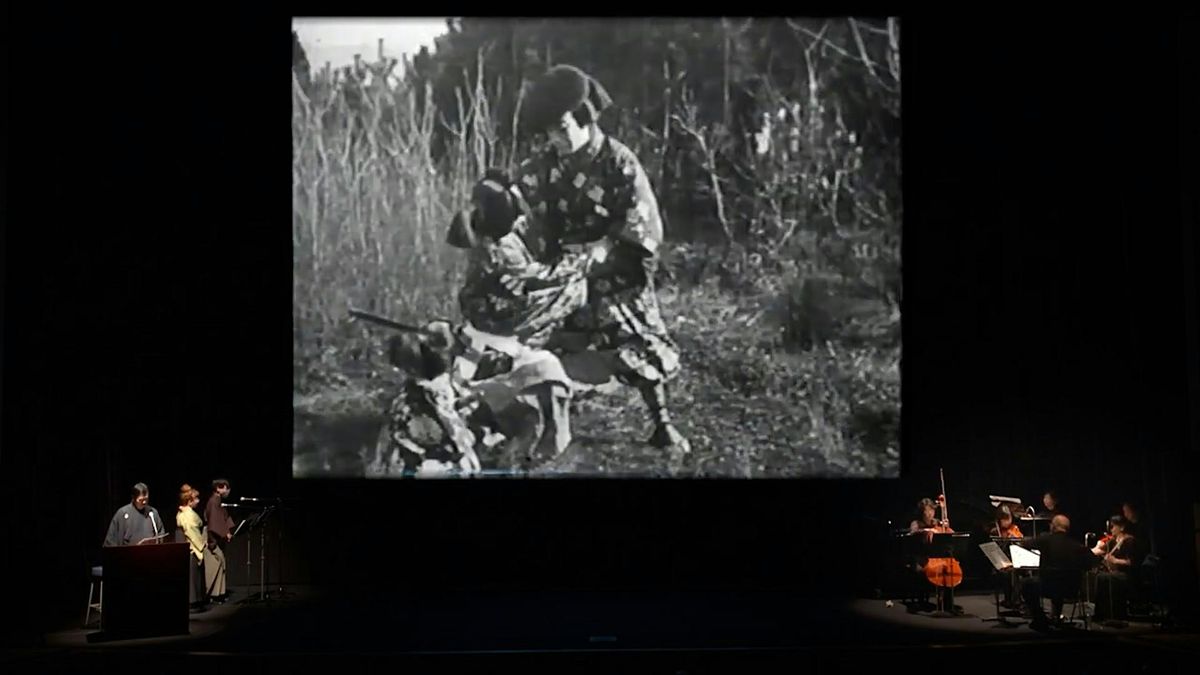
About this Event
This April, the Art of the Benshi 2024 World Tour offers audiences a rare opportunity to experience the mesmerizing artistry of three of Japan’s celebrated benshi—“movie orators” who, since the days of Thomas Edison’s Kinetoscope, have been breathing life into silent film. Joined by an ensemble of musicians from Japan, these masters of their art will transport viewers back to the golden age of silent film, when every movie screening was also a live performance.
The Dull Sword (Namakura gatana)
An overly-confident samurai looks for unsuspecting victims on which to try out his new sword but neither his targets nor his weapon prove willing to play along. The Dull Sword is the oldest known surviving example of moving image anime, simply drawn but highly expressive in its satirical take on period genre conventions. So that audiences can experience more directly how a benshi’s specific style can influence a film, The Dull Sword will be repeated over the course of this series with a different benshi narrating each time. DCP courtesy of the National Film Archive of Japan. (Dir: Kōchi Junichi, Japan, 1917, 5 min., DCP, silent, tinted)
A Straightforward Boy (Tokkan kozō)
Precocious children often take center stage in the works of Japanese master Ozu Yasujirō (I Was Born But…, Good Morning) with this fragment of a silent comedy short offering an early glimpse of his felicity with childhood. Trouble abounds for a pair of kidnappers who underestimate the energies of their young abductee who quickly challenges their patience for the job. This version includes seven more minutes than the previously known extant versions thanks to a newly-discovered print. (Dir: Yasujirō Ozu, Japan, 1929, 21 min., DCP, silent, tinted)
The Golden Flower (Kogane no hana)
This charming example of stop-motion collage tells the story of a ceremonial dancer who encounters a demon serpent in the hills while on his way home after performing at a harvest festival. He escapes the encounter and returns with a group of villagers to destroy the creature but its spirit has the last laugh. Produced by studio Chiyogami Eiga-sha, The Golden Flower suggests the rich variety of styles being explored by early Japanese animators. (Dir.: Noburō Ōfuji, Japan, 1929, 17 min., 35mm, silent)
The Water Magician (Taki no shiraito)
The elements of director Kenji Mizoguchi’s mature style are evident everywhere in this galvanizing melodrama adapted from a novel by Kyōka Izumi. High angle shots and sweeping camera movements lend a distinctly modern dynamism to the story of a woman (Takako Irie) who sacrifices everything she has to ensure the future of a young man (Tokihiko Okada) who captures her imagination. Irie delivers a powerful, moving performance as a theater performer whose good deed leads to tragedy as Mizoguchi (Ugetsu, The Life of Oharu) interrogates the shifting strata of Japanese society. Of course, benshi played an essential role in the original release of The Water Magician in Japan but the benshi of a generation later played an equally important role in the film’s restoration in 2006. DCP courtesy of the National Film Archive of Japan. (Dir.: Kenji Mizoguchi, Japan, 1933, 102 min., DCP, silent)
Event Venue & Nearby Stays
Meyer Auditorium, Freer Gallery of Art, Washington, United States
USD 0.00
